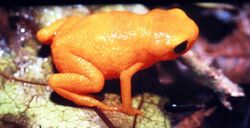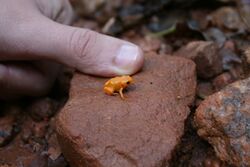Biology:Pumpkin toadlet
| Pumpkin toadlet | |
|---|---|

| |

| |
| Close-up (above), size compared to a human thumb (below) | |
| Scientific classification | |
| Domain: | Eukaryota |
| Kingdom: | Animalia |
| Phylum: | Chordata |
| Class: | Amphibia |
| Order: | Anura |
| Family: | Brachycephalidae |
| Genus: | Brachycephalus |
| Species: | B. ephippium
|
| Binomial name | |
| Brachycephalus ephippium (Spix, 1824)
| |
The pumpkin toadlet (Brachycephalus ephippium), or Spix's saddleback toad, is a small and brightly coloured species of frog in the family Brachycephalidae. This diurnal species is endemic to southeastern Brazil where it is found among leaf litter on the floor of Atlantic rainforests at an altitude of 200–1,250 m (660–4,100 ft).[2] It is found in Espírito Santo, Rio de Janeiro, southeastern São Paulo and southeastern Minas Gerais. Although its type specimen supposedly was collected in Bahia about 200 years ago, there are no confirmed localities in this state and recent reviews consider it more likely that it was from Rio de Janeiro.[2][3] B. ephippium is locally common,[3] quite widespread compared to most other species of Brachycephalus and it is not considered threatened.[1][2]
B. ephippium feeds on tiny invertebrates and breeding is by direct development, with the female laying a few eggs on land that hatch into young toadlets (no tadpole stage).[4]
Appearance and toxicity
File:Intense bone fluorescence reveals hidden patterns in pumpkin toadlets - video 1 - 41598 2019 41959 MOESM2 ESM.webm B. ephippium is a very small frog with a snout–to–vent length of 12.5–19.7 mm (0.49–0.78 in) in adults,[5] but it is among the largest in its genus together with species like B. darkside, B. garbeanus and B. margaritatus.[6][7] Females tend to be larger than males.[3] When newly hatched B. ephippium typically measure just 5.25–5.45 mm (0.207–0.215 in).[4]
B. ephippium is overall bright yellow-orange and this is considered aposematic (warning colours) since its skin and organs contain tetrodotoxin and similar toxins.[8] Newly hatched B. ephippium are well-camouflaged and brown overall.[4] 11-oxoTTX (11-oxotetrodotoxin), an isolated analogue is extremely rare to be found in other animals, even marine animals, this analogue is considered four to five times more potent than the tetrodotoxin itself.[9] Other analogues isolated of this toad include the tetrodonic acid, 4-epipetrodotoxin, 4.9 anhydrotetrodotoxin and 11-nortetrodotoxin.[10] The toxins can be found in their skin and ovaries, but mostly concentrated in the liver.
In 2019, scientists discovered that the head and back of this toadlet and the closely related red pumpkin toadlet (B. pitanga) glowed under ultraviolet light, due to their fluorescent skeletons.[11][12] Young that have gained the bright yellow-orange adult colours still lack their fluorescence. It was initially speculated that the fluorescent colour also is aposematic or that it is related to mate choice (species recognition or determining fitness of a potential partner),[12] but later studies indicate that the former explanation is unlikely, as predation attempts on the toadlets appear to be unaffected by the presence/absence of fluorescence.[13]
Call and hearing
Peculiarly, this species and the closely related red pumpkin toadlet are unable to hear the frequency of their own advertising calls, as their ears are underdeveloped. Instead their communication appears to rely on certain movements like the vocal sac that inflates when calling, mouth gaping and waving of their arms.[14][15] It is speculated that their calling is a vestigiality from the ancestral form of the genus, whereas their reduced hearing ability (they do have some hearing ability in frequencies outside their call) is a novel change in these species. Sounds make them more vulnerable to predators, but there has likely been little direct evolutionary pressure to lose it because of their toxicity.[14][15]
See also
- Polka-dot tree frog (Hypsiboas punctatus) — the first frog discovered to be fluorescent, in 2017
References
- ↑ Jump up to: 1.0 1.1 Monique Van Sluys, Carlos Frederico da Rocha (2010). "Brachycephalus ephippium". IUCN Red List of Threatened Species 2010: e.T54453A11149233. doi:10.2305/IUCN.UK.2010-2.RLTS.T54453A11149233.en. https://www.iucnredlist.org/species/54453/11149233. Retrieved 16 November 2021.
- ↑ Jump up to: 2.0 2.1 2.2 Bornschein, M.R.; M.R. Pie; L. Teixeira (2019). "Conservation Status of Brachycephalus Toadlets (Anura: Brachycephalidae) from the Brazilian Atlantic Rainforest". Diversity 11 (9): 150. doi:10.3390/d11090150.
- ↑ Jump up to: 3.0 3.1 3.2 Pombal, Jr, J.P.; E.M. Wistuba; M.R. Bornschein (1998). "A New Species of Brachycephalid (Anura) from the Atlantic Rain Forest of Brazil". Journal of Herpetology 32 (1): 70–74. doi:10.2307/1565481.
- ↑ Jump up to: 4.0 4.1 4.2 Pombal, Jr., J.P.; I. Sazima; C.F.B. Haddad (1994). "Breeding Behavior of the Pumpkin Toadlet, Brachycephalus ephippium (Brachycephalidae)". Journal of Herpetology 28 (4): 516–519. doi:10.2307/1564972.
- ↑ "Brachycephalus ephippium". Berkeley, California: AmphibiaWeb. 2019. https://amphibiaweb.org/species/2033.
- ↑ Guimarães, Carla Silva; Luz, Sofia; Rocha, Pedro Carvalho; Feio, Renato Neves (2017). "The dark side of pumpkin toadlet: a new species of Brachycephalus (Anura: Brachycephalidae) from Serra do Brigadeiro, southeastern Brazil". Zootaxa 4258 (4): 327–344. doi:10.11646/zootaxa.4258.4.2. PMID 28609910. http://www.locus.ufv.br/handle/123456789/18845.
- ↑ Condez, T.H.; Monteiro, J.P.D.; Comitti, E.J.; Garcia, P.C.A.; Amaral, I.B.; Haddad, C.F.B. (2016). "A new species of flea-toad (Anura: Brachycephalidae) from southern Atlantic Forest, Brazil". Zootaxa 4083 (1): 40–56. doi:10.11646/zootaxa.4083.1.2. PMID 27394218.
- ↑ Pires Jr., O.R.; A. Sebben; E.F. Schwartz; S.W. Largura; C. Bloch Jr.; R.A. Morales; C.A. Schwartz (2002). "Occurrence of tetrodotoxin and its analogues in the Brazilian frog Brachycephalus ephippium (Anura: Brachycephalidae)". Toxicon 40 (6): 761–766. doi:10.1016/s0041-0101(01)00279-3. PMID 12175613.
- ↑ Pires, Osmindo R.; Sebben, Antonio; Schwartz, Elisabeth Ferroni; Bloch, Carlos; Morales, Rodrigo A. V.; Schwartz, Carlos A. (October 2003). "The occurrence of 11-oxotetrodotoxin, a rare tetrodotoxin analogue, in the brachycephalidae frog Brachycephalus ephippium". Toxicon 42 (5): 563–566. doi:10.1016/s0041-0101(03)00235-6. ISSN 0041-0101. PMID 14529740. https://pubmed.ncbi.nlm.nih.gov/14529740/.
- ↑ Pires, Osmindo R.; Sebben, Antonio; Schwartz, Elisabeth F.; Largura, Simone W.R.; Bloch, Carlos; Morales, Rodrigo A.V.; Schwartz, Carlos A. (2002). "Occurrence of tetrodotoxin and its analogues in the Brazilian frog Brachycephalus ephippium (Anura: Brachycephalidae)". Toxicon 40 (6): 761–766. doi:10.1016/S0041-0101(01)00279-3. PMID 12175613. https://www.researchgate.net/publication/11210874.
- ↑ Fox, Alex (2 April 2019). "Scientists discover a frog with glowing bones" (in en). https://www.science.org/content/article/scientists-discover-frog-glowing-bones?et_rid=555477153&et_cid=2765237.
- ↑ Jump up to: 12.0 12.1 Sandra Goutte; Matthew J. Mason; Marta M. Antoniazzi; Carlos Jared; Didier Merle; Lilian Cazes; Luís Felipe Toledo; Hanane el-Hafci et al. (2019). "Intense bone fluorescence reveals hidden patterns in pumpkin toadlets". Scientific Reports 9 (1): 5388. doi:10.1038/s41598-019-41959-8. PMID 30926879. Bibcode: 2019NatSR...9.5388G.
- ↑ Rebouças, R.; A.B. Carollo; M.d.O. Freitas; C. Lambertini; R.M. Nogueira dos Santos; L.F. Toledo (2019). "Conservation Status of Brachycephalus Toadlets (Anura: Brachycephalidae) from the Brazilian Atlantic Rainforest". Diversity 55 (1): 39–47. doi:10.3390/d11090150.
- ↑ Jump up to: 14.0 14.1 Goutte, S. (2017). "Evidence of auditory insensitivity to vocalization frequencies in two frogs". Scientific Reports 7 (1): 12121. doi:10.1038/s41598-017-12145-5. PMID 28935936. Bibcode: 2017NatSR...712121G.
- ↑ Jump up to: 15.0 15.1 Supriya, L. (26 September 2017). "These tiny frogs can't hear their own mating songs". https://www.science.org/content/article/these-tiny-frogs-can-t-hear-their-own-mating-songs.
Wikidata ☰ Q1499291 entry
 |



